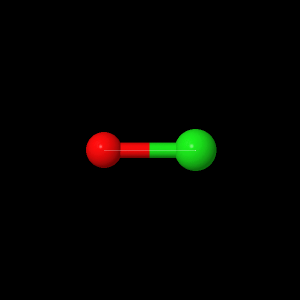Once the molecule file is fully loaded, the image at right will become live. At that time the "activate 3-D" icon ![]() will disappear.
will disappear.
Chlorine Monoxide Anion
The bond length of chlorine monoxide anionwas was find using different
energy levels. The length between chlorine and oxygen were found using
AM1 energy level. The length between chlorine and oxygen were found using PM3 energy level as well.
The electrostatic potential of the molecule shows where the highest and lowest potentials are in the orbitals. The blue color shows where the electrostatic potential is the highest while the red shows where it is the lowest.
The orbitals and their labels are expressed in Table 1 starting from the s orbitals all the way to the HOMO.
Table1: Pictures of each orbital with its corresponding label, including bonding/antibonding and sigma/pi properties.
| Bonding |
Orbital |
| S-Sigma Antibonding |
|
| S-Sigma Antibonding |
|
| S-Sigma Antibonding |
|
| P-Sigma Antibonding |
|
| P-Pi Bonding |
|
| P-Pi Bonding |
|
| S-Sigma Bonding |
|
| S-Sigma Antibonding |
|
| P-Pi Bonding |
|
| P-Pi Bonding |
|
| P-Sigma Bonding |
|
| P-Pi Antibonding |
|
| P-Pi Antibonding |
Figure 1 shows the different potential energies of bond stretching at the three higher levels of theory, 6-21G, 6-31G, and DZV. As the level of theory increases, the measure of lowest potential energy gets lower and lower as the calculations get closer to the true value. Despite the graph being fairly straight, it is not perfect. The slight rise in the line after the initial dip is due to the unaccounted for electrons in each theory's calculations. Ideally the line would be straight after the dip but such is not the case.

Figure 1: Depicts the potential energy in Hartrees of each higher level of theory. This graph was made in IgorPro.
The dipole moment was found by taking the optimized geometry log file in MacMolPlt of the energy level DZV, 6-31G, and 6-21G (table 2,3, and 4).
Table 2: Energy Level DZV on ClO- optimized geometry, different diffuse functions were done on the molecule to improve dipole moment.For this energy level the F orbital could not exceed a value greater than 1.
| Function | Dipole Moment (Debye) |
| 111 |
2.69 |
| 112 |
2.69 |
| 113 |
2.69 |
| 211 |
2.49 |
| 212 |
2.49 |
| 213 |
2.49 |
| 311 |
2.35 |
| 312 |
2.35 |
| 313 |
2.35 |
Table 3: Energy Level 6-31G on ClO- optimized geometry, different diffuse functions were done on the molecule to find the best dipole moment.For this level of energy the F orbital could not exceed 1.
| Function |
Dipole Moment (Debye) |
| 111 |
2.26 |
| 112 |
2.26 |
| 113 |
2.26 |
| 211 |
2.07 |
| 212 |
2.07 |
| 213 |
2.07 |
| 311 |
2.12 |
| 312 |
2.12 |
| 313 |
2.12 |
Table 4: Energy Level 6-21G on ClO- optimized geometry, different diffuse functions were done on the molecule to find the best dipole moment. For this level of energy the F orbital could not exceed 0.
| Function |
Dipole Moment (Debye) |
| 101 |
0.90 |
| 102 |
0.90 |
| 103 |
0.90 |
| 201 |
1.06 |
| 202 |
1.06 |
| 203 |
1.06 |
| 301 |
1.04 |
| 302 |
1.04 |
| 303 |
1.04 |
The dipole moment changed based off the s-orbital that was changing. For all the functions with 1 for the s position, the dipole moments were the same and changed as it was moved to 2 and 3. The dipole moment also changed with the energy level. NIST3 had no experimental value for the dipole moment. The calculated value of ClO- on NIST for the 6-31G level was 1.16 According to this, the the diffuse function portraying the closest value would be the 211, 212, and 213.
The calculated vibrational frequency of ClO- was found to me 289.15 cm-1. From the NIST website the vibrational frequency for energy level 6-31G was 470 cm-1.3
Page skeleton and JavaScript generated by export to web function using Jmol 14.1.8 2014-02-10 21:43: on Mar 4, 2014.
This will be the viewer


If your browser/OS combination is Java capable, you will get snappier performance if you use Java